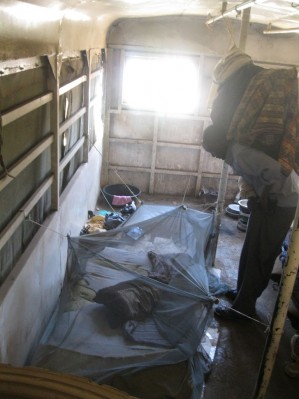
In my eight months working with RefugePoint, I’ve often been impressed and moved by the strength of the communities refugees have created for themselves in their new home. Most of our clients seem to have a story about other refugees—strangers—helping them in those first desperate hours after arrival, giving them shelter in already crowded rooms or sharing already meager meals. Though refugees have often seen firsthand how fragile the bonds that tie us together can be, those experiences seem to have bred not pessimism and suspicion but an even more fervent belief in the ideals of community, generosity, and fellowship.
But even within the close-knit refugee community, there are those who fall through the cracks. Recently, I met a man named Hassan*, who fled to Kenya after witnessing his entire family perish when their house was shelled. Plagued by chronic ulcers that give him uncontrollable diarrhea, he felt too ashamed to ask other refugees for shelter. He ended up living in a junkyard, holed up in an old truck trailer half-filled with dirty tractor tires. He had to plead with nearby business owners daily to use their bathrooms, and cooked whatever food he could beg or scrounge each day over an open brazier lent to him by the junkyard guards. When I asked him what was most difficult about his living situation, he took a long time to answer—there were too many hardships to choose from. Finally, shaking his head, he mentioned the chill that crept through his unglazed windows every night, easily penetrating his thin cotton blanket. “It would get so cold,” he said, “I couldn’t even dream.”
RefugePoint recently moved Hassan into a room in another family’s apartment where he will have a real bathroom to use and neighbors with whom to socialize. His ulcers are improving on drugs administered by our medical team. I hope that he’ll eventually find his way back into the community. But he reminds me that there are always those who hide in the shadows, too ashamed of their problems even to ask for help.
Then there are those refugees for whom the collective safety net becomes more like a cage. A few weeks ago I spoke with a woman, Farah*, whose husband abandoned her to live abroad. Soon afterward, what had been occasional chiding from her mother-in-law became a constant tide of emotional abuse. Farah was told she was a bad wife, a bad mother, and that her children would be better off without her. Kidnappings committed by the relatives of a departed husband are sadly common among Somalis, and Farah decided she’d do whatever it took to keep what was left of her family intact. One morning, while her mother-in-law was at the market, she slipped away with only her children and a small bag of belongings. Even now, though, she doesn’t feel safe—she still hears about threats made against her by her husband’s relatives, and she won’t let the children out of the house lest they be spotted and snatched up.
“They ask why they can’t go to school, go out to play. I don’t want to tell them and give them my worry,” she says, her legs tucked up beneath her on the twin bed she shares with her two young daughters. For Farah, the closeness of her community has been not a blessing but a curse; having lost her husband, she now can’t escape those who want to take her children from her too.
The strength of refugee communities in Nairobi is inspiring. But for some they bring not comfort and stability but stigma and persecution. That’s why RefugePoint’s commitment to seeking out even those who—in their shame or fear—don’t want to be found is so important. It’s those refugees—cast out from the community of outcasts—who are most vulnerable of all.
*Names are changed for our clients’ safety.
This piece is authored by Kate Orazem, RefugePoint Intern 2012-2013